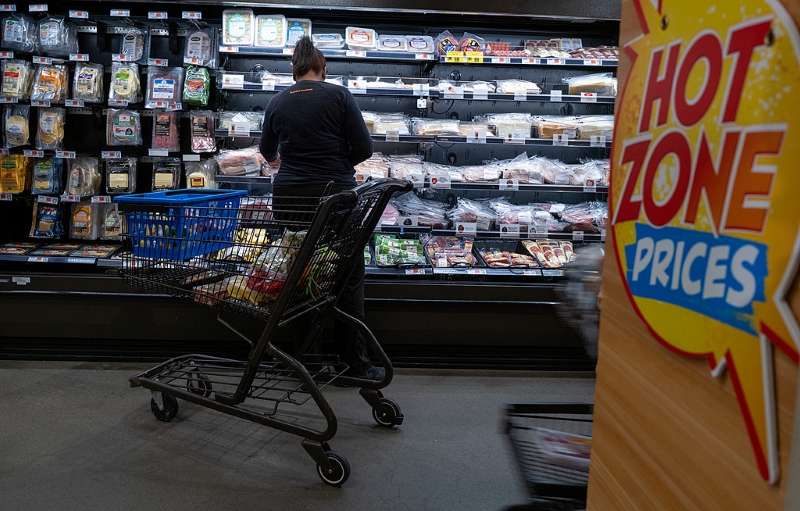Lately, there’s growing concern that the White House’s tariff policies will further drive up prices in the U.S. American media and scholars worry this could signal the end of the era of cheap consumer goods—undermining access to the so-called American Dream. Officials and experts, including Treasury Secretary Bessent and former Vice President Mike Pence, are publicly debating whether affordable goods are essential to that dream. Historian Richard Cohen argues that access to low-cost consumer goods is already part of American identity. He notes that in the history of American consumerism, shopping has even been tied to patriotism. If tariffs drive up everyday prices, the U.S. could face serious challenges.
In 2024, Does the American Dream Cost $4.4 Million?
On May 20, Federal Reserve officials warned that new tariffs from the White House could lead to rising prices. The next day, Nike announced price hikes on some of its products in the U.S. market. While Nike did not directly blame the Trump administration’s tariffs, CNBC pointed out that the footwear industry is especially vulnerable, with about half of Nike’s shoes made in China and Vietnam.
Public opinion widely holds that the White House’s move to impose so-called “reciprocal tariffs” on other countries will push up prices within the U.S. Walmart, the country’s largest retailer known for its low prices, recently warned that items ranging from bananas to car seats will become more expensive. Around 90% of American households shop at Walmart, with over 150 million customers visiting its stores or website each week. Rick Helfenbein, CEO of the American Apparel & Footwear Association, told CNBC that even though the U.S. has recently adjusted its tariff policy on China, current rates are still high enough to keep prices rising.
Some U.S. media outlets and scholars fear that the White House’s tariff strategy will make it harder for Americans to access affordable goods—putting the American Dream further out of reach. According to personal finance site GoBankingRates, the American Dream is often defined as the belief that anyone can succeed in the U.S. through hard work and determination. That dream includes owning a home, having a steady job, and achieving upward mobility.
The New York Post reported that in 2024, the cost of achieving the American Dream is estimated at $4.4 million. That includes getting married, buying a house and a car, raising two children and sending them to college, and saving for retirement. The figure is up $1 million from 2023, largely due to high inflation. Following the White House’s announcement of new tariffs, many now worry that the American Dream is becoming even more expensive.
The latest GoBankingRates report warns that new U.S. tariffs could derail many middle-class families’ path to financial security, pushing the American Dream further out of reach. The report outlines six ways tariffs are raising costs, including housing, cars, and essentials. Ricardo, CEO of legal tech firm InPerSuit, said tariffs on steel and lumber could push the price of a $280,000 home up to $317,000—potentially pricing out first-time buyers earning $60,000 a year.
The National Retail Federation (NRF) echoed concerns, stating that small businesses—which make up 98% of U.S. retailers and support over 13 million jobs—are especially vulnerable. Higher costs will be passed to consumers, damaging confidence and reducing spending. With thin margins, many small businesses may not survive the added burden.
Cheap Goods and American Identity
Treasury Secretary Bessent argues that cheap goods aren’t central to the American Dream, which she defines as upward mobility and economic security. But critics say she misses the point. Former Vice President Mike Pence said affordable toys are part of the dream. Others argue that the ability to easily buy phones, TVs, and other goods is what allows people to dream at all.
Vox reported that affordable goods have fundamentally shaped American life. While material things aren’t the “essence” of the Dream, they underpin the freedom to pursue it. Reason magazine noted that low-cost goods unite Americans across class and belief. Bloomberg took it further, saying cheap products are the American Dream—a decades-long bargain that let people get by without universal welfare.
According to PBS, post-WWII America equated consumption with patriotism. Harvard historian Richard Cohen told NPR that a booming postwar economy depended on high wages, high consumption, and job creation. From 1945 to 1949, Americans bought 20 million refrigerators and over 21 million cars. The 1950s continued that consumer surge.
Cohen explained that by the 1950s and ’60s, buying became personal: a way to express lifestyle and identity. Historian Elaine Tyler May added that postwar consumerism helped blur class lines and reinforced traditional gender roles. When consumer goods became widely accessible, the working class saw a path to upward mobility.
Cohen summed it up: “Wanting a car or the latest TV defines what Americans expect materially.” He warned that rising prices from tariffs threaten this foundation. “It could seriously shake confidence. We have to remember—70% of U.S. GDP comes from consumption.”
Li Haidong, professor at the Institute of International Relations at China Foreign Affairs University, told that the “American Dream” essentially refers to the opportunity for all individuals—especially those with talent but without family background or privilege—to improve their social status, build wealth, and gain dignity in the United States. Affordable goods form the basic foundation of realizing this dream. Without widespread access to low-cost products, the daily lives of ordinary Americans cannot be guaranteed, let alone their pursuit of dreams. There is indeed a link between the American Dream and affordable goods, and rising prices will undoubtedly exacerbate the wealth gap, cutting off many people’s material pathway to a better life and higher status. This, Li said, is the tragedy of the American Dream.
In Li’s view, figures like Treasury Secretary Bessent are caught in a dilemma. They argue that tariffs help the working class and support the American Dream, but the reality is that higher prices on daily goods caused by tariffs make that dream harder to achieve for regular workers.
“It Might Lose This Bet”
On April 2, when announcing the implementation of so-called “reciprocal tariffs” on various countries, U.S. President Donald Trump claimed that other nations had “stolen” American jobs and “undermined” what was once a beautiful American Dream. He asserted that the tariff policy would restore the American Dream and create more jobs for U.S. workers.
However, Zhang Jiadong, professor at Fudan University’s Center for American Studies, told that the real reason for the outsourcing of American low- and mid-end manufacturing is not tariffs but the vast gap in production costs between the U.S. and other countries—something tariffs cannot fix. High production costs in the U.S. are not just due to labor prices, but also cultural and social factors. In a developed country like the U.S. with high per capita income, most people are unwilling to work in low-end manufacturing. That is the core issue. If this problem is not addressed, the U.S. cannot produce cheap consumer goods domestically. As the saying goes, “you can’t have your cake and eat it too.” Dollar hegemony has enabled Americans to enjoy low-cost imports; if the U.S. wants to produce these goods itself, it would have to abandon that hegemony and accept a weaker dollar. In other words, only when Americans can no longer afford foreign goods will domestic production become feasible.
Li Haidong added that multilateral trade mechanisms have contributed to the abundance and prosperity of goods and do not, in themselves, block social mobility. The real issue in the U.S. is domestic wealth inequality. One of the main reasons Americans feel stuck is that wealthy elites—such as those on Wall Street and in Silicon Valley—monopolize most of the country’s income, leaving the majority feeling left out. This problem is not caused by free trade or multilateral agreements, nor can it be solved by tariffs. The core issue lies in the current U.S. income distribution system. One of the biggest challenges the U.S. faces today is how to effectively prevent the “Matthew Effect,” where the rich get richer and the poor get poorer.
According to a May 14 article on the website of the Brookings Institution, the White House was not surprised by retaliation from other countries over the new tariff policies. What did surprise them, however, was the strong opposition at home—particularly among young people, voters without college degrees, individuals earning under $50,000 annually, and Hispanic voters. These groups were major supporters of Trump in the last election.
A joint poll released by CNN and SSRS on March 12 showed that 61% of Americans and 72% of young people disapproved of the White House’s handling of tariffs. Among Americans without college degrees, 59% expressed disapproval; among those earning under $50,000 annually, the figure was 62%. Similar results were reported in mid-February by The Washington Post and Ipsos, as well as in a March 13 poll by Quinnipiac University.
Bloomberg reported that although Americans often say they support U.S.-made products in surveys, their actual shopping behavior over decades shows a stronger preference for low prices and reliable availability. A February poll by CBS News and British polling agency YouGov found that 80% of Americans believe the White House should prioritize tackling inflation, but only 29% think it is doing so effectively. As the Brookings Institution article concluded: “The White House is betting that Americans will have the patience to endure high prices and even economic slowdown—but it might lose that bet.”













Leave a comment